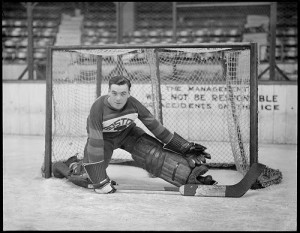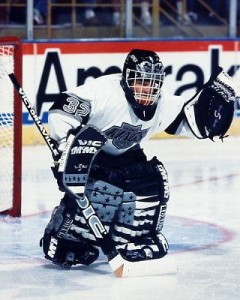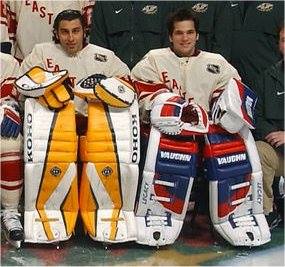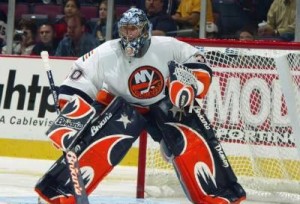Goalie Pads Then and Now: A Look at the New Pad Restrictions
Goaltending through the years has been an ever-evolving science and trade, combining modern anatomical science with old fashioned grit. Goaltending we see today looks nothing like its bare-faced predecessor. The first goalies weren’t even allowed to go down on both knees to make a save, much less try the groin-busting splits of the Hybrid Butterfly. Pads have changed dramatically in the last several decades, almost too dramatically, as so the NHL has once again implemented new rules in the 2013-14 season to limit the size/shape of netminders’ equipment. Before we go on a walk down memory lane to the yesteryears of Jaques Plante and Gump Worsley, let’s have a look at the anatomy of goalie pads.
Goalie Pad 101:
It’s hard to think of something that hasn’t been improved by technology. Heck, these days you can even repel rats electronically thanks to modern science. The modern goalie leg pad has been modified from the old strap-on pillows to a technological masterpiece of puck-stopping engineering. Mainly, the Knee Stacks, or “Landing Gear,” that allow a goalie to go down on their knees without injuring them, and also allow the rectangular block of the pad to lie flush to the ice, preventing anything from sliding under it (unless you’re Marc-Andre Fleury…) are the biggest improvement.
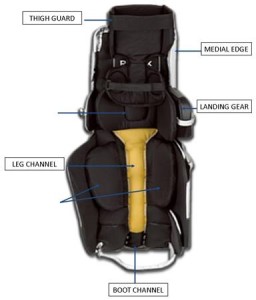
As the “Butterfly” style improved, the desire to close off the area between the legs (the Five Hole) was remedied by what pad manufacturers call the “Thigh Rise.” Thigh Rise describes how many extra inches above the top of the knee that are added for extra closure when a goalie goes down in the butterfly. Pads are measured from floor to knee, so let’s say you wear a 34” pad, and then want an extra 3 inches of thigh rise, your pads would be labeled 34+3. Thigh Rise offers no extra protection, and removing it does not add any extra risk of injury, but we’ll touch on that later. Adding the thigh rise isn’t enough for most goalies, so to get it to curve inward and create a seal with the other pad a “Break” is added. Some pads have a Break under the knee as well, for added flexibility.
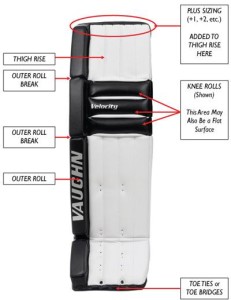
In the olden days of flat wooden sticks, most shots rarely rose above the waist level, and goalies could generally get away with not wearing a mask and having limited chest protection. The modern player is a genetically amped athlete, armed with carbon-fiber curved-blade sticks capable of placing a 100mph shot anywhere they want. Naturally, as shooters got stronger and more accurate, the goalie had to compensate. In 1928, Bruins Goalie Tiny Thompson (below) doesn’t even have a blocker, wears a modified baseball mitt, and looks to only have the most minimal of padding on his chest.
For goalies that stood up and made kick saves most of the time, that was perfectly acceptable. Fast forward a few decades when guys like Stan Makita and Gordie Howe are winging wrist shots by your ears and the goalies of the era had to beef of the padding and start covering their faces like Gary Cheevers, who painted stitches on his mask in the places he was hit, signifying the injuries the mask saved him from.
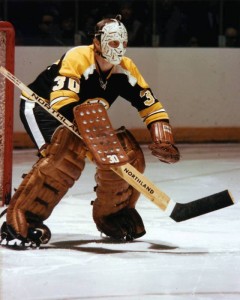
Once goalies started to accept more padding, some of them went overboard. In the late 80s and early 90’s the pads weren’t getting any taller, as thigh rise hadn’t taken hold yet, but they were getting much wider. Guys like Arturs Irbe of the Sharks and Kelly Hrudey of the Kings were some of the worst offenders, with pads exceeding 12” wide per leg.
Once Thigh Rise was introduced, goalies went wild, wearing enormous chest protectors under tent-sized sweaters and double-wide pants. Best example is shown here in this picture of Roberto Luongo and Jose Theodore in 2004.
Keep in mind Luongo is only 4 inches taller and 35lbs heavier than Theodore. It was this kind of limit pushing that brought on the changes during the 2005 lockout that regulated goalie pads to be adjusted proportionally to the goalie’s size on a sliding scale (i.e. bigger pads for small guys, smaller pads for big guys.) and regulated that no leg pad be wider that 11”. With that, the days of the Stay-Puft Marshmallow Goalies were over.
That brings us to the current Lockout, and the new restrictions that have resulted from that. Previously, goalie pads could be no taller than 38” (unless you are a giant like the Blues’ 6’7” Ben Bishop) so guys with a 35” measurement would add a +3 Thigh Rise to stay just under the limit and take up all the extra space they can. The NHL decided that no more than a +1.5 thigh rise would be acceptable in 2013. Many people decried the fact that this was dangerous, and that goalies’ knees would now be exposed to blistering shots. Not true. In fact, even without the Thigh Rise, many goalies wear plastic-capped knee pads under their socks, and many more wear flip-up thigh boards that cover the knee when a goalie goes down. Other than forcing the goalie to squeeze a little harder to close the 5-hole, there is no compromise of safety. As a goalie myself who uses a 36+1, I think the pros can handle it, no matter how much Heinrich Lundqvist protests on Twitter.
—
Scott Huntington is a writer, reporter, blogger, and long-time hockey fan. He’co-creator and admin of the hockey group Soft Dump. Follow Scott at @SMHuntington
